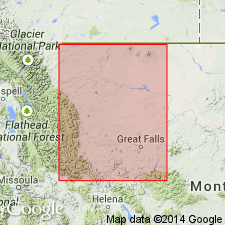
- Usage in publication:
-
- Swift formation
- Modifications:
-
- Named
- Dominant lithology:
-
- Sandstone
- Shale
- AAPG geologic province:
-
- Sweetgrass arch
- Montana folded belt
Summary:
Named as upper formation of Ellis group for Swift Reservoir on Birch Creek, NE1/4 sec 27, T28N, R10W, Pondera Co, MT on Sweetgrass arch. Shown as extending west into Montana folded belt province. [Map area does not show east and south limits beyond Sweetgrass arch.] Is 134+ ft thick at type measured section where it is divided into a lower shale member (54 ft 6 in) and an upper sandstone member. Shale member is dark gray to greenish, fine-grained and varies from highly glauconitic, very finely micaceous, calcareous to noncalcareous. Sandstone member has a dark gray, hard, lenticular conglomerate of black chert pebbles in basal part, water-worn belemnites, oyster fragments, worm? tubes, fish teeth, and glauconite in a fine calcareous sandy matrix at base. Was deposited over entire Sweetgrass arch. Isopach map. Removed from most of Cut Bank area and in small area west of Whitlash dome during pre-Kootenai erosion. Ranges from 10 ft at Stockett to 155 ft in subsurface of Midway field. Ten measured sections (4 subsurface). Overlies Rierdon formation (new) of Ellis. Underlies Morrison formation. Lower member is Divesian and Argovian age (belemnites, p. 288). Upper member is Argovian age. A marine unit. Of Late Jurassic age.
Source: GNU records (USGS DDS-6; Denver GNULEX).
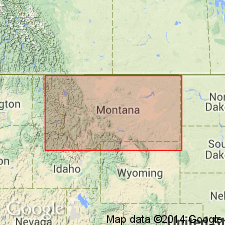
- Usage in publication:
-
- Swift formation*
- Modifications:
-
- Areal extent
- Biostratigraphic dating
- AAPG geologic province:
-
- Central Montana uplift
- Sweetgrass arch
- Williston basin
- Powder River basin
- Bighorn basin
- Montana folded belt
Summary:
Described and correlated in measured sections in north-central, central, and south-central MT. Consists mainly of glauconitic sandstone and shale. More widespread in MT than underlying marine Jurassic formations. Overlies Rierdon formation with a sharp disconformable contact. Contact with overlying Morrison formation appears to be conformable. Discusses faunas and basis for dating. Age is Late Jurassic (Oxfordian and perhaps latest Callovian), based on ammonites.
Source: GNU records (USGS DDS-6; Denver GNULEX).
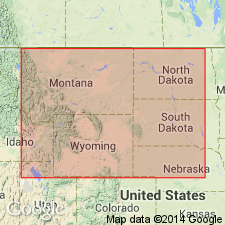
- Usage in publication:
-
- Swift unit
- Modifications:
-
- Overview
- AAPG geologic province:
-
- Williston basin
- Powder River basin
- Central Montana uplift
- Sweetgrass arch
- Bighorn basin
- Montana folded belt
- Wind River basin
Summary:
Defined as Swift formation in northwestern and central MT, upper part of Sundance formation in Saskatchewan, Manitoba, eastern MT, and ND; Redwater shale member of Sundance formation in the Black Hills area, WY and SD; "upper Sundance" formation in most of WY, and Stump formation in eastern ID. Shows correlation, thickness, and lithofacies, and makes tectonic and environmental interpretations. Underlain unconformably by Rierdon unit; overlain conformably by Morrison formation. Late Jurassic (Oxfordian) in age.
Source: GNU records (USGS DDS-6; Denver GNULEX).
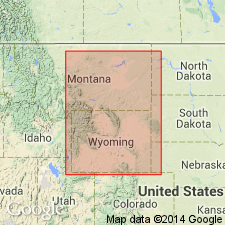
- Usage in publication:
-
- Swift formation
- Modifications:
-
- Overview
- Areal extent
- AAPG geologic province:
-
- Powder River basin
- Chadron arch
- Denver basin
Summary:
Extends name into eastern WY, southwestern SD, and northwestern NE in Powder River basin, northwestern part of Chadron arch, and northern part of Denver basin. Made the upper of two units in Sundance group [hereby raised in rank from Sundance formation]. Is the "upper Sundance" [of central WY] or Redwater [shale member of Sundance formation] of the Black Hills. Discusses distribution, thickness, correlation, and fossils, including distribution of ostracodes and ammonites. Shows restored isopach map for Swift formation and equivalent rocks in WY, eastern MT, and bordering parts of ND, SD, and NE. Appears to disconformably overlie Rierdon formation in most places. Conformable with overlying Morrison formation. Is Late Jurassic (Oxfordian) in age.
Source: GNU records (USGS DDS-6; Denver GNULEX).
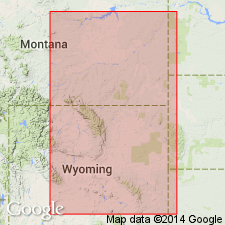
- Usage in publication:
-
- Swift formation
- Modifications:
-
- Biostratigraphic dating
- AAPG geologic province:
-
- Central Montana uplift
- Powder River basin
- Williston basin
- Chadron arch
- Bighorn basin
- Wind River basin
- Montana folded belt
Summary:
Describes 22 species of Upper [Late] Jurassic (Callovian) OSTRACODA, collected from outcrops at 21 localities in MT, WY, and SD. Concludes that the "upper Sundance"--Swift (Oxfordian) OSTRACODA assemblage is distinctly different from the "lower Sundance"--Rierdon assemblage. Is Late Jurassic (Oxfordian) in age.
Source: GNU records (USGS DDS-6; Denver GNULEX).
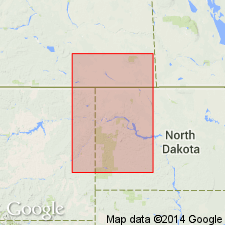
- Usage in publication:
-
- Swift formation
- Modifications:
-
- Revised
- Overview
- Areal extent
- AAPG geologic province:
-
- Williston basin
Summary:
Divided into a lower calcareous shale member, a middle sandstone member, and an upper noncalcareous shale member. Mapped as a separate unit in the western part of Williston basin. Equivalent strata included in Sundance formation in the eastern part of the basin. Upper member of Swift was placed in Morrison formation by Schmitt (1953). Overlies Rierdon formation unconformably in central MT, and conformably in the central part of Williston basin [in eastern MT and western ND]. Overlain by Morrison formation. Is Late Jurassic in age. [Additional details in Francis, D. R., 1957, American Association of Petroleum Geologists Bulletin, v. 41, no. 3, p. 372-376 (figs. 2-4), p. 379 (table 1), and p. 387-391.]
Source: GNU records (USGS DDS-6; Denver GNULEX).
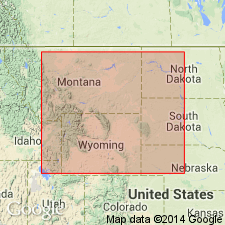
- Usage in publication:
-
- Swift formation
- Modifications:
-
- Overview
- AAPG geologic province:
-
- Williston basin
- Powder River basin
- Central Montana uplift
- Sweetgrass arch
- Bighorn basin
- Montana folded belt
Summary:
Uppermost formation of Ellis group. In subsurface throughout the Williston basin, includes a lower shale unit and an upper sandstone unit. Age is Late Jurassic (Oxfordian). Report includes isopach map, correlation diagrams, and environments of Swift formation and equivalents in northern Rocky Mountains, Williston basin and nearby regions.
Source: Modified from GNU records (USGS DDS-6; Denver GNULEX).
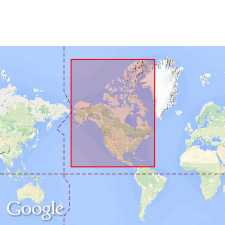
- Usage in publication:
-
- Swift Formation*
- Modifications:
-
- Overview
- AAPG geologic province:
-
- Williston basin
- Central Montana uplift
- Montana folded belt
- Sweetgrass arch
Summary:
Is upper formation of Ellis Group [term not mentioned in this report]. Is more widespread than any of the underlying formations of Ellis. Is as much as 165 ft thick in outcrop and more than 400 ft thick in subsurface. Occurs from Swift Reservoir, Montana folded belt province, east, Sweetgrass arch and Central Montana uplift, to the Williston basin of MT and north into Canada in the Saskatchewan subsurface. Divisible in Sawtooth Range into two transitional members that pinch out on Sweetgrass arch but reappear farther east as shalier units. Age of basal beds varies. Is early Oxfordian at some localities and middle Oxfordian at others. Upper age limit uncertain. Could be top of Oxfordian. Could be as young as Kimmeridgian. Paleogeography of Middle Jurassic time described. Large correlation charts.
Source: GNU records (USGS DDS-6; Denver GNULEX).
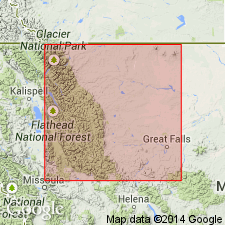
- Usage in publication:
-
- Swift Formation*
- Modifications:
-
- Revised
- AAPG geologic province:
-
- Sweetgrass arch
Summary:
Underlies with angular unconformity Cut Bank Sandstone Member (extended to Sawtooth Range, Teton Co, MT on the Sweetgrass arch where it is assigned to Kootenai Formation as its basal member) of Mount Pablo Formation (new). Rocks of Mount Pablo were formerly included in Kootenai in the Sawtooths. Of Late Jurassic age.
Source: GNU records (USGS DDS-6; Denver GNULEX).
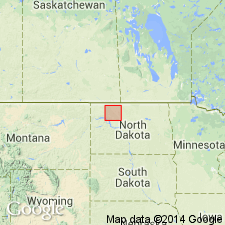
- Usage in publication:
-
- Swift Formation
- Modifications:
-
- Overview
- Revised
- AAPG geologic province:
-
- Williston basin
Summary:
Divides lower 150 ft of formation into units A through E (ascending) in Mountrail and adjacent parts of Ward, Renville, and Burke Cos., ND in the Williston basin. Randomly scattered carbonate sand bodies variably replace units A, B, and C. The sand bodies probably are large offshore sand bars deposited during the final transgression of the shallow epicontinental sea [in Jurassic time] across the irregular shelf floor of the eastern Williston basin. Isopach maps and correlation show the distribution of the sandstone bodies. Is Late Jurassic (Oxfordian) in age.
Source: GNU records (USGS DDS-6; Denver GNULEX).
For more information, please contact Nancy Stamm, Geologic Names Committee Secretary.
Asterisk (*) indicates published by U.S. Geological Survey authors.
"No current usage" (†) implies that a name has been abandoned or has fallen into disuse. Former usage and, if known, replacement name given in parentheses ( ).
Slash (/) indicates name conflicts with nomenclatural guidelines (CSN, 1933; ACSN, 1961, 1970; NACSN, 1983, 2005, 2021). May be explained within brackets ([ ]).

